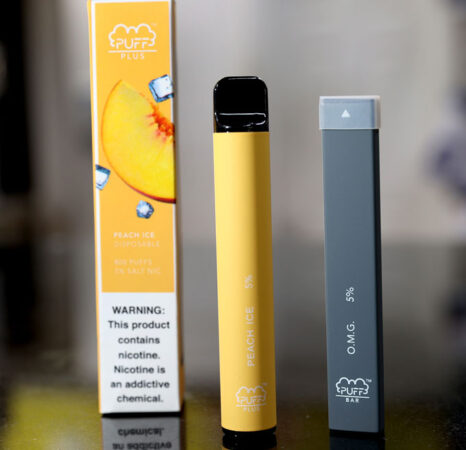Warning! Nicotine poses special risks to teens
It leads to a miswiring of their brains’ neural circuits that lasts well into adulthood

Vaping as a teen frequently leads to smoking cigarettes as an adult and can set up the brain for other addictive behaviors, as well.
Yana Iskayeva/Moment/Getty Images Plus
The next time someone offers you their e-cigarette, you might want to think twice before taking a puff. You’re not just vaping water with some added flavoring. You’ll be inhaling a cloud of other ingredients, too, such propylene glycol and vegetable glycerine. These are generally thought to be safe for use in food. But we don’t know that it’s safe to pull them into our lungs. Vape liquids also contain metals, formaldehyde and other toxic ingredients. But among the most concerning ingredients in most vape liquids is nicotine.
“A lot of teens get their vaping products from their friends,” says Suchitra Krishnan-Sarin. She is an addiction psychiatrist at Yale University in New Haven, Conn. “They don’t necessarily purchase them or do the research on them,” she points out. And that means they don’t know what they’re inhaling when they start to puff.
Krishnan-Sarin studies teen vaping. She’s found that teens are most likely to use non-refillable (also known as closed system) devices. These small, easy-to-hide products — such as JUUL and Puff Bar — don’t create an obvious vape cloud. This makes them easy to use almost anywhere. In fact, Krishnan-Sarin says, “Kids would tell us they were using these products in the classroom.”
Before COVID (the last time she was able to study teen vaping habits), many teens “were puffing on [an e-cigarette] almost constantly throughout the day,” she says.
That’s a concern. “None of these closed-system products come without nicotine,” Krishnan-Sarin notes. In fact, a single JUUL pod contains the same amount of nicotine as a pack of cigarettes. Both JUUL and Puff Bar also use a salt form of nicotine that gives each puff a smoother feel. That makes it more pleasurable.
Teens are “very sensitive to low levels of nicotine,” Krishnan-Sarin reports. “They also get addicted to nicotine a lot faster,” she notes. Vaping as a teen leads to long-term changes in the brain. These often lead to nicotine addiction. Those changes also can prime the brain for addiction problems with other types of drugs.

The problem with nicotine
Nicotine is highly addictive. It’s the reason three in every four people who start smoking or vaping as a teen continue to do so as adults. That addiction is also what makes it so hard to stop.
Nicotine acts directly on cells in the brain. Some neurons have receptors that bind with nicotine. When someone inhales nicotine, it travels to the brain. There it binds to these receptors. This releases a flood of dopamine, a neurotransmitter that creates upbeat, happy feelings. This positive sensation makes people want to use nicotine again. But over time, it takes more nicotine to get that same reward. That sets up a cycle of craving and use that leads to addiction.

Robert Smith is a retired neuroscientist at George Mason University in Fairfax, Va. His lab was among the first to study the effects of nicotine on the adolescent brain. His team examined individual brain cells in rats that had been exposed to nicotine. “We can’t do these kinds of studies with humans,” he notes. But “the brain chemistry of humans and rats is very, very similar.”
In a 2007 study, his team found that young rats (the equivalent of human teenagers) were more sensitive to nicotine than were adults. What’s more, it took just one dose to alter the young rat’s reward system. That’s the brain network that uses dopamine to create positive feelings. And this brain rewiring lasted into adulthood.
It’s not just the reward system that changes, Smith has found. Rats given nicotine as adolescents don’t respond to stress as well as adults do. They’re afraid of new situations. Generally, they “act fearful and anxious,” he found. Those changes in behavior were linked to changes in brain connections.
A 2015 study found specific changes among cells in a brain region that is involved with fear. Neurons in this nucleus accumbens (NU-klee-us Ah-KUM-bens) have long fibers called axons that relay signals to other cells. These signals are picked up by branched dendrites on the receiving cell. When the researchers gave adolescent rats nicotine, the dendrites of cells in the nucleus accumbens ended up with extra branches. That didn’t happen in adult rats. Extra dendrites suggest the young rats had more connections between cells. Moreover, Smith points out, “The changes we found … are strongly associated with fear behavior.”
The team doesn’t know whether the dendrites grow new branches in response to nicotine. It could be that older branches simply weren’t pruned away. Adolescence is a time of major brain development. Connections between some neurons grow stronger. Others are removed, or pruned, like the branches of a tree. The process should create a more efficient adult brain. Using nicotine during this critical time appears to change the way the brain reorganizes in this preparation for adulthood.

Educators and Parents, Sign Up for The Cheat Sheet
Weekly updates to help you use Science News Explores in the learning environment
Thank you for signing up!
There was a problem signing you up.
Pruning gone wrong
Frances Leslie’s team at the University of California, Irvine, has found similar brain changes. She is a retired neuroscientist. Like Smith, she led early research into nicotine’s effects on the adolescent brain. Leslie focused on synapses (SIN-app-sez) — connections between neurons. In “normal brain development, synapses [that are] used a lot are left,” she says. “The ones that aren’t used much are pruned.”
But nicotine throws a wrench into that pruning. Leslie has found that nicotine use during adolescence causes inflammation in the brain. That kicks the brain’s immune cells — called microglia — into gear.
Microglia “gobble up trash in the brain,” Leslie explains. “As [the] brain develops, microglia are important,” she says. To make the brain more efficient, they remove links that are no longer needed. That’s good — if the synapses they prune are the ones that need to go. But nicotine exposure causes “microglia to prune away synapses that shouldn’t be pruned,” Leslie says. She has documented such changes in the nucleus accumbens and the basolateral amygdala (Ah-MIG-dah-la). Both regions are involved with anxiety and fear — as well as reward and addiction.
Part of brain development involves strengthening connections between different brain regions. This happens when axons grow from one region to another. Such superhighways are essential for a properly functioning brain. But if the wrong synapses get pruned, Leslie says, “they probably won’t return.” Affected brain regions won’t communicate well. And that leads to long-term changes in how the brain is organized.
Such changes most likely occur at specific stages of brain development. Early adolescence is a big one. That’s when the brain builds many essential connections that it will use for life. Changes to its wiring at this stage could have life-long impacts.
These changes may be the reason why teens who start smoking struggle with addiction even as adults. That’s not just true of nicotine addiction. People who use nicotine at a young age also are more likely to later use other drugs — such as alcohol.
In 2019, a team at Pennsylvania State University in University Park confirmed that in rats. The rodents exposed to nicotine as adolescents were more likely to binge drink large amounts of alcohol, too. The team then identified genes with different patterns of activity in these rats. Some influenced brain inflammation. Others affected signaling between cells. Such changes at the genetic level may explain the brain changes Smith and Leslie uncovered.

Added stress
“Nicotine is a very potent drug,” says Carlos Bolaños-Guzmán. He is a neuroscientist at Texas A&M University in College Station. Nicotine has wide-ranging effects on the developing brain. And it may lead to mental health problems, his team finds.
“What comes first?” he asks. Anxiety and depression — or nicotine use? For many years, researchers thought people with anxiety and depression used nicotine to self-medicate. But there’s mounting evidence that the early teenage use of nicotine may actually cause those mental health issues.
In one 2009 study, Bolaños-Guzmán’s team found that as little as one day of exposure to nicotine could have a lasting negative effect in rodents. But only if that exposure happened during adolescence.
Rats don’t like to be out in the open. It stresses them out. So the researchers studied rats that had been exposed to nicotine as adolescents in an open field. These animals showed more signs of stress than did those unexposed to the drug — or exposed only as adults. Affected rats also showed no interest in sugar water, which they normally love. Lack of interest in positive experiences is one symptom of depression. Another is having difficulty dealing with challenges. Rats exposed to nicotine when they were young showed changes in both types of behaviors.
We can’t say for certain that a rat is depressed, Bolaños-Guzmán says. So he says scientists must “draw inferences based on behavior.” If they see behaviors that are similar to those in depressed people, he says, we can say the rat is in a depression-like state. “Obviously they’re not human,” he notes, “but the similarities are uncanny.”
Using nicotine may sound “like a rite of passage,” says Smith. “But it really can affect brain growth and development.” Does that mean everyone who takes a puff as a teen will end up addicted to nicotine? Not at all. Beforehand, “nobody knows if they are susceptible,” notes Bolaños-Guzmán. “The question is, do you want to find out?” When he asks his students this question, their answer is always no.
“Just don’t start if you can avoid it,” says Krishnan-Sarin. “If you can’t, at least know what you are using. If a friend offers you something, make sure you know what’s in it before you actually use it.” If it has nicotine, take a pass.







